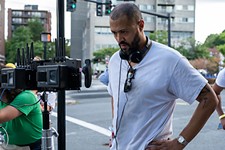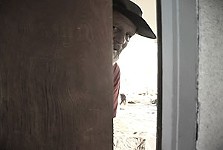Ride in the Whirlwind
Hellman's cult uses Western frontier justice to reflect the political climate of the mid-Sixties.
Reviewed by Eli Kooris, Fri., Nov. 15, 2002
RIDE IN THE WHIRLWIND (1966)
D: Monte Hellman; with Jack Nicholson, Millie Perkins, Katherine Squire, Cameron Mitchell, Harry Dean Stanton, George Mitchell.
In 1965, director Monte Hellman and a rising star named Jack Nicholson set off to the badlands of Utah to shoot Ride in the Whirlwind, a Western the two produced together, based on a script by the young actor. Nicholson also stars in the film, as one of three cowboys riding home to Waco through the wilds of the West. Tired after a day of traveling, they come across a small cabin of ominous, armed characters led by Blind Dick (a frail Stanton, wearing an eye patch). Unbeknownst to the cowboys, the cabin of men are laying low after robbing a stagecoach earlier in the day -- not quite low enough, it seems, as the following morning they find themselves surrounded by a large, trigger-happy posse of vigilantes. The three cowboys are caught in the ensuing crossfire and flee for their lives. Assuming they are part of the gang of robbers, the posse gives chase. Knowing that reasoning with the posse is out of the question, the cowboys are forced to become criminals themselves in order to survive, and, with this shift, Ride in the Whirlwind's subtle political message begins to take shape. Frontier justice -- swift, violent retribution -- can sometimes catch innocent people in its midst. Hellman's film is an indirect parallel to the nation's rocky political situation in the mid-Sixties, a nation reeling from the Kennedy assassination and facing the escalation of the "conflict" in Vietnam. A similar statement is made in The Shooting, a sister Western filmed just after the wrap of Ride in the Whirlwind with an identical cast and crew; according to the director, The Shooting is a metaphor for the short-lived fame of Lee Harvey Oswald. Both of these cult classics suffer from poor sound quality and a minimalist approach to character development, but they're distinguished by outstanding performances and engaging, morally twisty story lines that preluded the late Sixties' coming storm.










